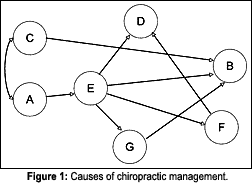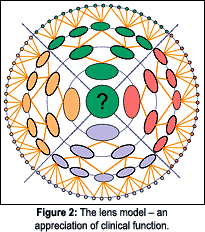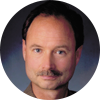Happy the man who has been able to learn the causes of things.
~ Virgil
Why do chiropractic patients get better? And why should "why" even matter? To some chiropractors, the entire chiropractic management process is reason enough why patients improve.
Cause is tricky. The cause (or causation) question may seem like nitpicking insurance bean counters harassing you. And for the record, they really are harassing you. They know a whole lot less about cause than you do. So, it is time to get informed and respond to the causal question in a grown-up way, to at least understand it enough to defend your own clinical strategies and methods.
For the record, cause is one ancient and big deal in science and philosophy. It is harder to say just what causes stuff than you might think. Lots of words have been published and presented on the matter. (Lots' of ale swilled.) Einhorn and Hogarth1 tackle the cause issue by laying out "cues-to-causality," including "covariation, temporal order, contiguity in time and space."
All this is assuming, of course, that time progresses in one direction only, and that wormholes between parallel universes don't mess us up. But time-positive progression and wormholes are the least of chiropractic's problems. The big idea about cause is that it is a slippery devil, and lots of smart people have thought long and hard about it. For the past decade or so, the specter of cause has been knocking on chiropractic's door. So far, chiropractors have refused to receive this guest for fear of his mood, appetite, motives, size, and the amount of hair on his back. In other words, will cause dine with us, or on us?
Cause might be a Trojan horse of some kind, smuggling in all manner of hell. "Who the hell are you and what do you really want?" At first glance, chiropractic's suspicion of science has some basis. To date, the science of chiropractic has been limited to its "active ingredient:" the adjustment (and just how medical is that?). Adjustments are lumped in with manipulation not always performed by chiropractors. Data are analyzed by methods and means that work well for pill-for-an-ill medicine, but maybe not so well for chiropractic medicine. In any case, the chiropractic clinician takes note: Chiropractic seems to make so many lives better, but science says no, or not really, or evidence insufficient, or not supported.
Chiropractic grew up under the "one-cause/one-cure" model in an age when such ideas were perfectly reasonable. Deterministic models such as "one cause" say that for every antecedent A there is a consequence B. If A, then B; if B, there must be an A around here somewhere. Subluxation to illness; cure subluxation to cure illness.
Some chiropractors still focus today on one cause, for a variety of reasons.
But in a speech to your local Rotary (I am a proud Paul Harris Fellow), any declaration that subluxation causes disease will stimulate nervous fidgeting and quick but polite glances at the clock. The Rotary audience of business leaders will have been asked to suspend disbelief for 30 minutes. Your pastor, if he is in the audience, will hang with you. He understands the trials and tribulations of true believers.
When declaring that one event requires another event to happen, you automatically lose about 90 percent of today's audience. It's kind of like smoking - no one believes in it anymore. Over the past 100 years, more realistic models have emerged that more closely match our experience and data. Determinism went the way of the horse and buggy; you still see a few buggies around, but nobody knows how to drive one. As chiropractors, we want to at least refer to a Ferrari just to let everyone know we know they exist. Chiropractors still may choose to practice low-tech treatments, as I believe we should, but our ideas of cause are contemporary and integrative.
The current model of cause is stochastic. "Stochastic" is a fancy word for random. This model says, in short, that random stuff happens. Or that lots of stuff happens that we cannot see, so we say it is random. Random events make people sick and random events can help make them better. Every clinician includes, whether he or she knows it or not, random events in treatment.
No doubt chiropractors see results every day - sometimes right off the table. Chiropractors also see daily the reversal of health fortunes that go with comorbidities, re-injuries, new diseases, and just random life circumstances and events. The master clinician limits bad random events and promotes - or more chiropractically, allows - events that improve health. Rest, ice, compress, and elevate reduce activity and give focus to getting well, in addition to just reducing swelling.
"Yes, spinal adjusting can be amazing. But why you, Mrs. Patient, are in my office probably did not come from a single event, and I, as a chiropractic clinician, will be remiss if I give you a single treatment. With the story you give me and the data I collect, I will design a treatment program, and together we will give it a shot for a length of time. With your progress, we shall continue treatment. With anything less than progress, I reserve the right to order more tests or send you out for another opinion."
So, really, chiropractic cause - what works and is at work in the chiropractic office - is less like simply A to B and more like figure 1.
And clinical tests and examinations look more like figure 2.
 Figure 1 oversimplifies modern chiropractors' clinical tasks. Factors A and C are only two of many pertinent facts used; for example, age and location of injury. The intervening steps, D through G, include history and examination and other increments that influence each other, and build successive steps toward health, finally leading to an outcome B, whatever that may be (e.g., less pain, better function, etc.). A similar model could be made for how the patient got sick to begin with. But that is not your problem. Your problem is decoding and changing the trajectory of health and life. The "innate" cause is just as much the clinician's care and support as the patient's readiness to repair.
Figure 1 oversimplifies modern chiropractors' clinical tasks. Factors A and C are only two of many pertinent facts used; for example, age and location of injury. The intervening steps, D through G, include history and examination and other increments that influence each other, and build successive steps toward health, finally leading to an outcome B, whatever that may be (e.g., less pain, better function, etc.). A similar model could be made for how the patient got sick to begin with. But that is not your problem. Your problem is decoding and changing the trajectory of health and life. The "innate" cause is just as much the clinician's care and support as the patient's readiness to repair.
 Figure 2 was created by my colleague, Werner Wittman, PhD, from the University of Mannheim in Germany.2 This figure represents the Brunswik lens model3 - an elaborate attempt to observe what is going on deep inside from various facets (or lenses) we can see on the outside. Is subluxation at the center of the lenses? Is it the deepest singular cause of health? How about the mental, emotional, or spiritual as core? Is subluxation one more indicator of something yet deeper: say, a subluxation of lifestyle? Or is subluxation some mixture of symptoms together? Redness, pain, and swelling are the subluxation - or are they caused by it? Then just what do chiropractors treat?
Figure 2 was created by my colleague, Werner Wittman, PhD, from the University of Mannheim in Germany.2 This figure represents the Brunswik lens model3 - an elaborate attempt to observe what is going on deep inside from various facets (or lenses) we can see on the outside. Is subluxation at the center of the lenses? Is it the deepest singular cause of health? How about the mental, emotional, or spiritual as core? Is subluxation one more indicator of something yet deeper: say, a subluxation of lifestyle? Or is subluxation some mixture of symptoms together? Redness, pain, and swelling are the subluxation - or are they caused by it? Then just what do chiropractors treat?
So, what should cause mean to chiropractic clinicians? Do we really have to invite in our surly and dangerous causal guest? Is there some Wizard of Cause we should consult first? No one truly knows cause. But that is no excuse for not thinking deep and hard about it, because quite simply, more people's lives should be better as a result of encountering the chiropractor. The chiropractor's world should extend to church, community and beyond. That is chiropractic's fiducial role as a community resource and leader. The mature healer freely admits what he or she does not know, but may still try to help based upon some likely mechanisms. Chiropractors can be forgiven and paid for trying and failing with a common-sense causal plan based on a shared understanding of physiology and the enormous value of time. But cookie-cutter or extended care (even when based on heavily cited rationales) that do not add to real improvements will keep cause away only a little longer. Eventually, the door must be answered.
Your job, however, is mostly limited to within the four walls of your office. So, no matter what patients do in their personal lives, most of which you don't want to know about anyway, chiropractic in all its complexity is a force for positive change. Chiropractic then represents a significant commitment to health. This is the biggest big idea there is: to make chiropractic a true cause for healing.
References
- Einhorn HJ, Hogarth RM. Judging probable cause. Psych Bulletin 1986;99:3-19.
- Wittman WW, Walach H. Evaluating Complementary Medicine: Lessons to Be Learned From Evaluation Research. In: Lewith G, Jonas WB, Walach H, eds. Clinical Research in Complementary Therapies. New York: Churchill Livingstone; 2002.
- Hammond KR, Stewart TR. The Essential Brunswik: Beginnings, Explications, Applications. Oxford: Oxford University Press; 2001.
Click here for previous articles by J. Michael Menke, MA, DC, PhD.





